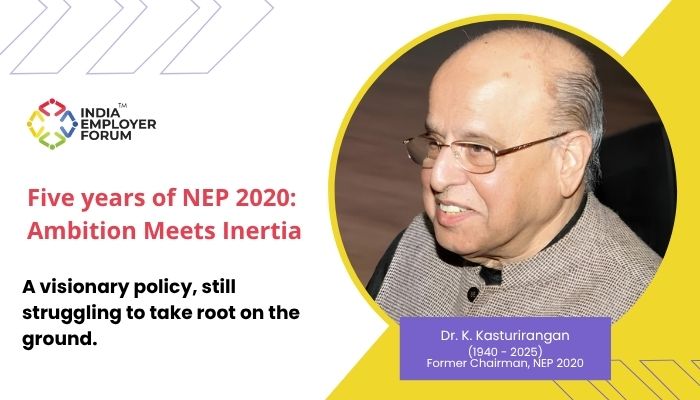In July 2020, India launched one of its most ambitious and long-overdue educational policy reforms: the National Education Policy (NEP) 2020. Framed after extensive consultation and touted as a 21st-century blueprint for “holistic, flexible, multidisciplinary” learning, the policy was a long-awaited response to the systemic inertia plaguing Indian education. With promises of transforming everything from curriculum structures to teaching practices, from digital infrastructure to foundational learning, NEP 2020 was, at its core, a declaration of intent to position education as a driving force for national development and individual empowerment.
Five years later, however, the story of its implementation tells a tale not of failure—but of fragmented ambition. The NEP’s transformative potential remains intact, but its realization is marred by uneven execution, political contestation, and infrastructural limitations that threaten to turn a policy of promise into a paper of platitudes.
A Visionary Framework
NEP 2020 did not lack foresight. It envisioned an India where every child enters school ready to learn, where universities foster innovation and interdisciplinary thinking, and where technology dissolves barriers to access. Its six structural pillars—Early Childhood Care and Education (ECCE), Foundational Literacy and Numeracy (FLN), Curriculum and Pedagogy Reform, Multilingual and Inclusive Education, Digital Learning, and Higher Education Transformation—were ambitious but contextually relevant. It sought to overhaul the outdated 10+2 system with the 5+3+3+4 model, introduce Multiple Entry-Exit Options in higher education, operationalize the Academic Bank of Credits, and expand the Gross Enrollment Ratio (GER) in higher education to 50% by 2035. The policy also promised universal FLN by 2026–27, 100% school enrollment, and a strong push for vocational education and employability. Yet, a policy is only as powerful as its implementation—and that’s where NEP 2020 has stumbled.
Foundational Literacy: Gains, but a Long Road Ahead
The NEP placed Foundational Literacy and Numeracy at the heart of its early-stage reform, recognizing that learning gaps begin as early as Class 1 and compound throughout a child’s academic journey. Under the NIPUN Bharat Mission, states were tasked with ensuring every child could read with understanding and perform basic arithmetic by Grade 3. There has been some measurable progress, albeit uneven. The ASER 2024 (Rural) report revealed that 23.4% of Class 3 students could now read a Class 2-level text—up from 16.3% in 2022. Similarly, 44.8% of Class 5 students met expected reading levels (up from 38.5%)., Through initiatives like Gunotsav 2.0, States like Gujarat have demonstrated a 180% increase in A+ rated primary schools. Uttar Pradesh improved reading proficiency in Grade 3 students from 12% in 2018 to nearly 28% in 2024, while Haryana’s NIPUN monitoring system tracks over 4.6 lakh students via a mobile app. Yet, disparities remain striking. The 2023 FLN Scorecard highlighted Punjab (64.2%), Kerala (58.4%), and Sikkim (56.8%) as top performers, while Uttar Pradesh (37.5%), Madhya Pradesh (14.4%), and Telangana (8.2%) languished at the bottom. In large parts of Bihar, Chhattisgarh, and the tribal belts, FLN efforts are hindered by teacher shortages, overcrowded classrooms, and limited community engagement. The existence of national frameworks and teacher training modules alone cannot compensate for gaps in classroom practice and local ownership.
Early Childhood Care: Building on Weak Foundations
NEP’s focus on Early Childhood Care and Education (ECCE) acknowledged decades of neglect in preschool learning. Initiatives like Uttarakhand’s “Bal Vatikas” and Jharkhand’s upgrading of 16,000 Anganwadis show early movement. ECCE participation reportedly reached 87% in 2020, with a target of 95% by 2025. However, these efforts often lack curricular alignment, trained facilitators, and appropriate infrastructure. Many Anganwadis continue to function more as nutrition centres than learning spaces. Without strong links between ECCE and Class 1, the transition remains broken—this discontinuity undermines early learning outcomes and leads to persistent academic underperformance.
Higher Education: A Promise Delayed
One of NEP’s boldest ambitions was to reform India’s higher education system into a flexible, modular, and globally competitive ecosystem. The policy promised a shift from rigid, exam-driven, siloed degree structures to a more flexible, interdisciplinary model aligned with global standards.. It envisioned a future where learners could chart their academic journeys with the freedom to pause, switch, or exit programs without penalty—akin to global education models that prize adaptability over uniformity. Central to this vision were structural innovations such as the Multiple Entry-Exit System (MEES), the creation of an Academic Bank of Credits (ABC) to digitally store and transfer academic records, the push for four-year multidisciplinary undergraduate programs, and the recruitment of “Professors of Practice” to bridge the persistent chasm between academia and industry.
Five years later, much of this remains more aspirational than operational. Only 36% of universities have adopted MEES, often constrained by infrastructure gaps, outdated curricula, and academic rigidities. While 700+ institutions have registered for ABC, its usage remains limited due to a lack of interoperability and regulatory clarity. Likewise, only 14% of universities have brought in “Professors of Practice,” deterred by institutional conservatism and unclear norms. The GER in higher education has risen marginally—from 27.3% in 2020 to 28.3% in 2024, far short of the 50% target. Access remains skewed against rural learners, women, and marginalized communities. To their credit, states like Odisha, Maharashtra, and Jammu & Kashmir have taken proactive steps to implement NEP-aligned reforms. However, Karnataka’s withdrawal from NEP in 2023, citing autonomy concerns, underscores how fragile the Centre-state consensus remains. The divide between private and public universities—with the former adapting more swiftly—has only widened systemic inequalities.
Digital Learning: Fast, but Not Far-Reaching
The pandemic offered NEP a unique opportunity to scale digital learning, and in many ways, it delivered. The DIKSHA platform logged 50 million users and over 3.5 billion content views. States like Uttar Pradesh invested in 7,400 smart classrooms, 5,200 ICT labs, and distributed 51,000 tablets to teachers. Delhi allocated ₹900 crore to equip nearly 19,000 classrooms with smart blackboards. But technology is not a silver bullet. Technology, while enabling scale, cannot substitute for foundational teaching quality, equity in access, and pedagogical relevance. Connectivity remains poor in rural and tribal districts. Digital literacy among teachers is patchy, and a lack of contextual, multilingual content limits uptake. Without parallel investment in teacher capacity and content localization, digital education risks becoming another source of exclusion rather than inclusion.
The Language Question and Political Pushback
NEP’s three-language policy and emphasis on multilingualism were intended to promote linguistic diversity. States like Punjab have creatively embraced this—offering French, Hindi, and Punjabi together. But Tamil Nadu, Kerala, and West Bengal have firmly opposed the language clause, calling it an imposition on regional autonomy. The lack of consensus underscores a larger problem, revealing the friction between national standardization and the federal diversity that defines Indian education. Education, being a concurrent subject, demands not just central leadership but state-level conviction and cooperation. NEP’s one-nation roadmap does not easily accommodate India’s many languages, curricula, and pedagogies.
Conclusion: Intent Is Not Impact
NEP 2020 was never just a policy—it was a statement of national purpose. It rightly recognized that education is the cornerstone of both economic growth and democratic empowerment. But as implementation unfolds, the gap between intent and impact remains stubborn. The policy still holds immense promise but potential alone cannot educate a nation. India must invest at scale—doubling public education spending to bring it closer to 6% of the GDP, build granular accountability mechanisms that go beyond reporting and dashboarding, strengthen inter-state collaboration and ensure states have the autonomy and support to adapt reforms to their context, and most critically, elevate the role of teachers, communities, and school leaders—not just as implementers but as co-creators of change. The NEP kindled that light in 2020. But keeping it burning, especially in every rural school, urban slum, and underfunded college, will demand more than visionary documents. It will require political will, fiscal commitment, and the humility to listen to the voices on the ground.
The clock is ticking—and the classroom is waiting.






